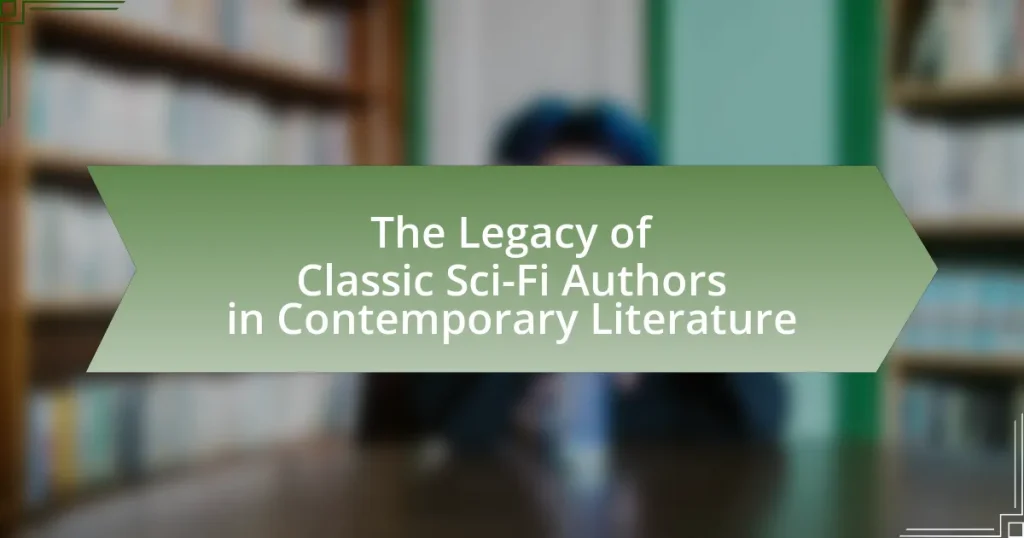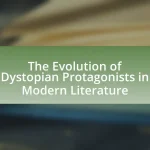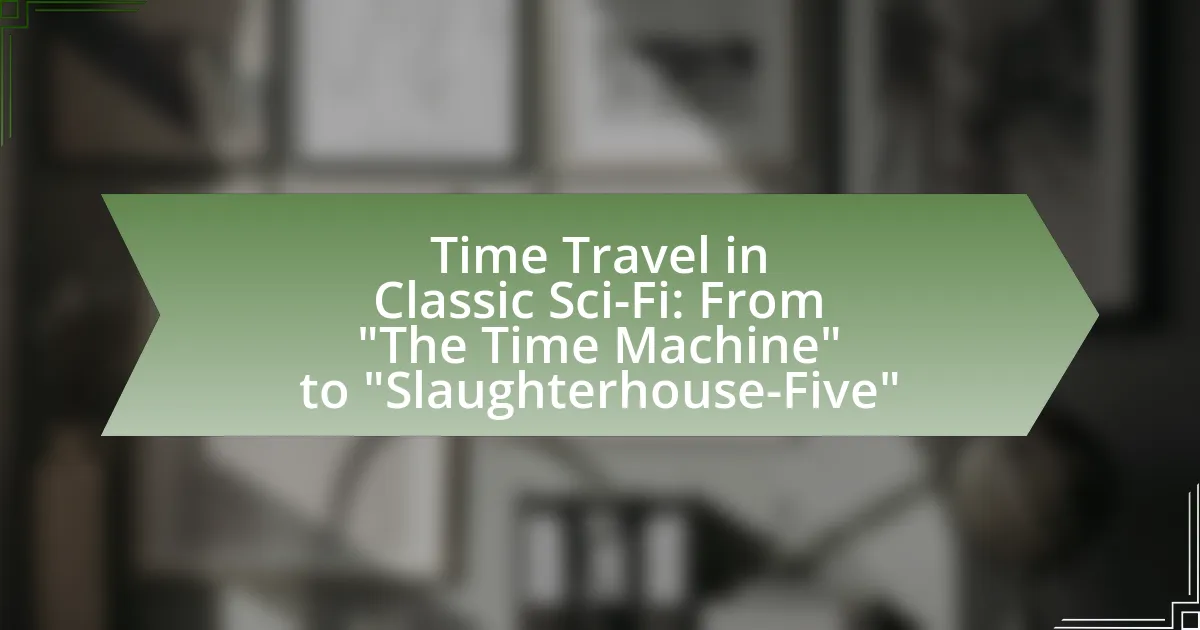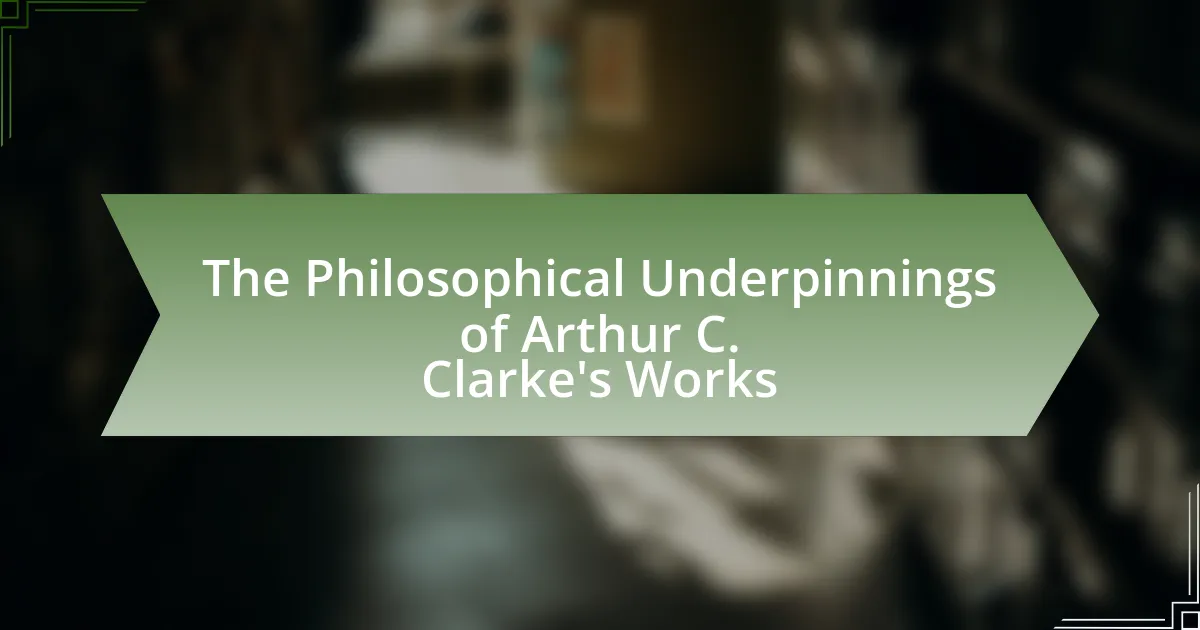The article examines the significant legacy of classic sci-fi authors, such as Isaac Asimov, Arthur C. Clarke, and Philip K. Dick, in shaping contemporary literature. It highlights how foundational concepts introduced by these authors, including artificial intelligence, dystopian themes, and complex character archetypes, continue to influence modern storytelling. The discussion includes the impact of classic narratives on current societal issues, the techniques contemporary authors use to reference classic works, and the ongoing relevance of these themes in today’s literary landscape. Additionally, it explores how adaptations of classic sci-fi inform new literary creations and the ways in which modern authors reinterpret and challenge original concepts.
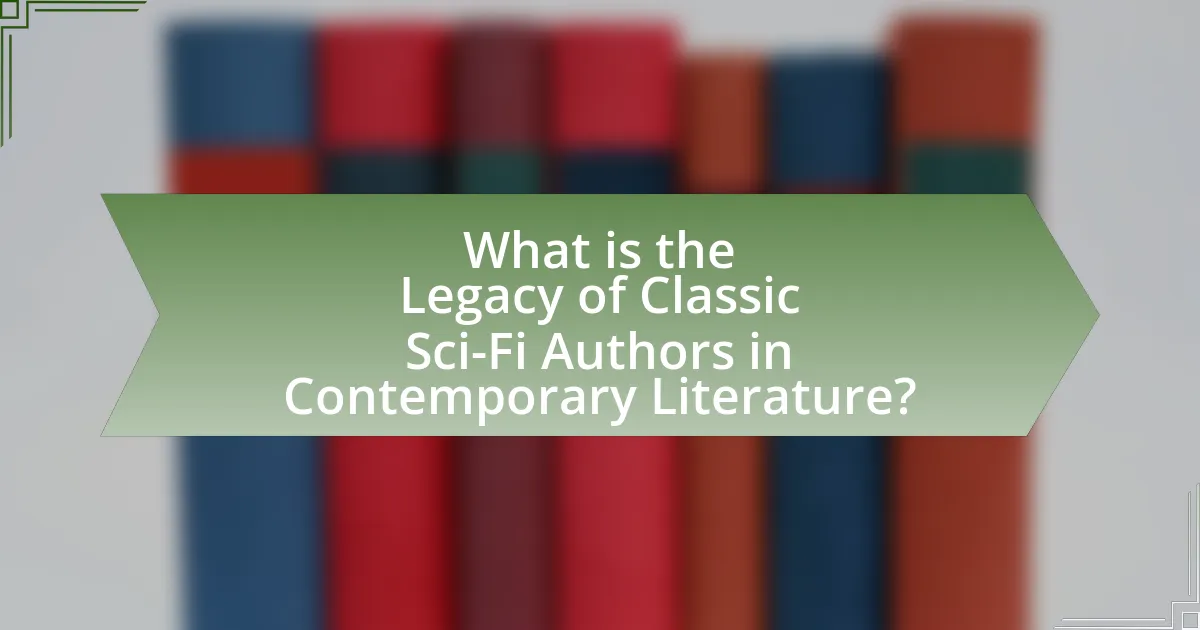
What is the Legacy of Classic Sci-Fi Authors in Contemporary Literature?
The legacy of classic sci-fi authors in contemporary literature is profound, influencing themes, narrative structures, and character development. Authors like Isaac Asimov and Arthur C. Clarke established foundational concepts such as robotics and space exploration, which continue to resonate in modern works. For instance, the ethical dilemmas surrounding artificial intelligence in contemporary novels often trace back to Asimov’s “Three Laws of Robotics.” Additionally, the exploration of dystopian futures, as seen in George Orwell’s “1984,” has shaped current narratives that critique societal norms and governance. This enduring impact is evident in the works of contemporary authors like Margaret Atwood and N.K. Jemisin, who draw on classic sci-fi motifs while addressing current social issues, thereby bridging the gap between past and present literary landscapes.
How have classic sci-fi authors influenced modern storytelling?
Classic sci-fi authors have significantly influenced modern storytelling by introducing complex themes, innovative world-building, and speculative concepts that challenge societal norms. For instance, works by authors like Isaac Asimov and Arthur C. Clarke have laid the groundwork for exploring artificial intelligence and space exploration, which are prevalent in contemporary narratives. Asimov’s “Foundation” series and Clarke’s “2001: A Space Odyssey” not only shaped the genre but also inspired filmmakers and writers to delve into philosophical questions about humanity’s future. Furthermore, the narrative techniques employed by classic authors, such as non-linear storytelling and multiple perspectives, have been adopted by modern writers to enhance narrative depth and engagement. This legacy is evident in popular franchises like “Star Wars” and “The Expanse,” which echo the thematic and structural innovations pioneered by their predecessors.
What themes from classic sci-fi are prevalent in contemporary works?
Contemporary works of science fiction frequently explore themes of dystopia, artificial intelligence, and the impact of technology on society, all of which were prominent in classic sci-fi literature. Dystopian narratives, such as those found in George Orwell’s “1984” and Aldous Huxley’s “Brave New World,” continue to resonate in modern stories like “The Hunger Games” series by Suzanne Collins, reflecting societal fears and critiques of governance. The theme of artificial intelligence, exemplified by Isaac Asimov’s “I, Robot,” is prevalent in contemporary works like “Ex Machina” and “Westworld,” raising ethical questions about consciousness and autonomy. Additionally, the exploration of technology’s effects on human relationships and identity, as seen in Philip K. Dick’s works, is echoed in contemporary narratives such as “Black Mirror,” which examines the consequences of technological advancements on personal and societal levels. These enduring themes illustrate the significant influence of classic sci-fi on modern storytelling.
How do character archetypes from classic sci-fi appear in today’s literature?
Character archetypes from classic sci-fi, such as the hero, the anti-hero, and the alien, prominently appear in today’s literature, reflecting enduring themes and societal concerns. For instance, the hero archetype is often embodied in protagonists who face moral dilemmas and existential threats, similar to characters in works by Isaac Asimov and Arthur C. Clarke. The anti-hero, a staple in classic sci-fi, is prevalent in contemporary narratives, showcasing flawed characters who challenge traditional notions of morality, as seen in works like “The Expanse” series. Additionally, the alien archetype continues to serve as a metaphor for the “other,” exploring themes of identity and belonging, which resonates in modern novels like “Children of Time” by Adrian Tchaikovsky. These archetypes not only connect contemporary literature to its classic roots but also adapt to reflect current cultural and technological anxieties, demonstrating their lasting relevance.
Why is the legacy of classic sci-fi authors significant today?
The legacy of classic sci-fi authors is significant today because their works laid the foundational concepts and themes that continue to influence modern science fiction. Authors like Isaac Asimov, Arthur C. Clarke, and Philip K. Dick introduced ideas such as artificial intelligence, space exploration, and alternate realities, which are prevalent in contemporary literature and media. For instance, Asimov’s “Three Laws of Robotics” remains a critical framework in discussions about AI ethics, while Clarke’s visions of space travel have inspired real-world advancements in aerospace technology. Their ability to explore complex social issues through speculative narratives has also paved the way for current authors to address contemporary challenges, such as climate change and technological ethics, making their legacy a vital part of the ongoing evolution of the genre.
What cultural impacts have classic sci-fi authors had on contemporary society?
Classic sci-fi authors have profoundly influenced contemporary society by shaping cultural narratives around technology, ethics, and human identity. Their works, such as Isaac Asimov’s “Foundation” series and Arthur C. Clarke’s “2001: A Space Odyssey,” introduced concepts like artificial intelligence and space exploration, which have become integral to modern discourse. These authors not only predicted technological advancements but also prompted critical discussions about their implications, as seen in the ongoing debates about AI ethics and the exploration of Mars. The themes they explored continue to resonate, inspiring filmmakers, writers, and thinkers, thereby embedding sci-fi’s imaginative frameworks into the fabric of contemporary culture.
How do classic sci-fi narratives shape current societal discussions?
Classic sci-fi narratives shape current societal discussions by providing frameworks for exploring complex issues such as technology, ethics, and human identity. For instance, works like George Orwell’s “1984” and Aldous Huxley’s “Brave New World” have sparked ongoing debates about surveillance, freedom, and societal control, influencing contemporary discourse on privacy and government authority. These narratives often serve as cautionary tales, prompting society to reflect on the implications of technological advancements and moral dilemmas, thereby fostering critical conversations about the future.
In what ways do contemporary authors pay homage to classic sci-fi?
Contemporary authors pay homage to classic sci-fi by incorporating themes, stylistic elements, and narrative structures that echo the works of earlier pioneers. For instance, many modern sci-fi novels explore dystopian futures, a hallmark of classic authors like George Orwell and Aldous Huxley, reflecting societal anxieties and moral dilemmas. Additionally, contemporary writers often reference iconic characters and settings from classic literature, such as the replicants in Philip K. Dick’s “Do Androids Dream of Electric Sheep?” which influence modern narratives about artificial intelligence. Furthermore, the use of speculative technology and philosophical questions about humanity, as seen in works by Isaac Asimov and Arthur C. Clarke, continues to inspire new generations of authors, who weave these elements into their storytelling to create a dialogue with the past.
What techniques do modern authors use to reference classic sci-fi works?
Modern authors reference classic sci-fi works through techniques such as allusion, homage, and intertextuality. Allusion involves subtle references to classic texts, allowing readers familiar with the originals to recognize and appreciate the connection, as seen in works like “The Power” by Naomi Alderman, which echoes themes from Mary Shelley’s “Frankenstein.” Homage pays direct tribute to classic authors or their themes, exemplified by the way “The Martian” by Andy Weir nods to the survival narratives found in classic sci-fi. Intertextuality creates a dialogue between texts, where modern narratives build upon or reinterpret classic ideas, as demonstrated in “The Long Way to a Small, Angry Planet” by Becky Chambers, which reflects on the societal structures explored in Isaac Asimov’s works. These techniques not only enrich contemporary narratives but also highlight the enduring influence of classic sci-fi on modern literature.
How do adaptations of classic sci-fi influence new literary creations?
Adaptations of classic sci-fi significantly influence new literary creations by providing foundational themes, character archetypes, and narrative structures that contemporary authors build upon. For instance, the adaptation of works like Isaac Asimov’s “Foundation” series into various media has inspired new explorations of complex societal structures and technological ethics in modern literature. Additionally, adaptations often reintroduce classic concepts to new audiences, prompting fresh interpretations and innovative storytelling techniques. This cyclical relationship between adaptations and original works fosters a rich dialogue within the genre, as seen in the resurgence of interest in dystopian narratives following adaptations of classics like George Orwell’s “1984.” Such influences are evident in the thematic depth and stylistic choices of contemporary sci-fi authors, who frequently reference or reinterpret classic elements to resonate with current societal issues.
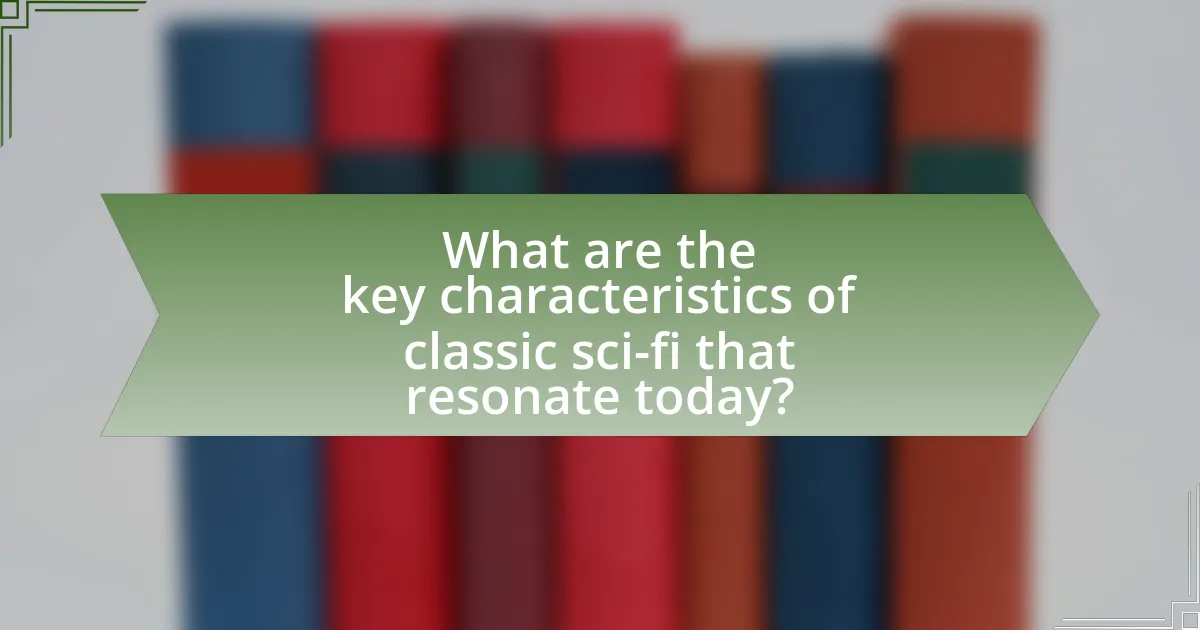
What are the key characteristics of classic sci-fi that resonate today?
The key characteristics of classic sci-fi that resonate today include imaginative world-building, exploration of ethical dilemmas, and the impact of technology on society. Imaginative world-building allows readers to envision alternate realities, as seen in works like Isaac Asimov’s “Foundation,” which explores complex societies and their evolution. The exploration of ethical dilemmas is exemplified in Philip K. Dick’s “Do Androids Dream of Electric Sheep?” which questions the nature of humanity and consciousness. Additionally, the impact of technology on society is a recurring theme, illustrated by Arthur C. Clarke’s “2001: A Space Odyssey,” which examines human evolution in relation to technological advancement. These characteristics continue to resonate as they address timeless questions about existence, morality, and the future of humanity.
How do speculative elements in classic sci-fi manifest in contemporary literature?
Speculative elements in classic sci-fi manifest in contemporary literature through themes of advanced technology, societal change, and existential questions. Contemporary authors often draw inspiration from classic works, incorporating futuristic settings and speculative technologies that challenge current societal norms, as seen in novels like “The Power” by Naomi Alderman, which explores gender dynamics through speculative scenarios. Additionally, the exploration of artificial intelligence and its implications, a common theme in classic sci-fi such as Isaac Asimov’s works, continues to resonate in contemporary narratives, reflecting ongoing debates about ethics and humanity’s future. This continuity illustrates how foundational speculative ideas from classic authors remain relevant and influential in shaping modern literary landscapes.
What role does technology play in both classic and modern sci-fi narratives?
Technology serves as a central theme in both classic and modern sci-fi narratives, often acting as a catalyst for exploring human nature and societal issues. In classic sci-fi, such as Isaac Asimov’s “I, Robot,” technology raises ethical questions about artificial intelligence and its implications for humanity. Similarly, modern narratives like “The Matrix” delve into the consequences of advanced technology on reality and identity. This continuity highlights how technology not only shapes the plot but also reflects cultural anxieties and aspirations, demonstrating its enduring significance in the genre.
How do classic sci-fi authors address social issues that remain relevant today?
Classic sci-fi authors address social issues that remain relevant today by using speculative narratives to explore themes such as inequality, technology’s impact on society, and environmental concerns. For instance, George Orwell’s “1984” critiques totalitarianism and surveillance, reflecting ongoing debates about privacy and government control. Similarly, Isaac Asimov’s “Foundation” series examines the rise and fall of civilizations, paralleling contemporary discussions on political power and social structures. These authors employ futuristic settings to highlight the consequences of current societal trends, making their works timeless reflections on human behavior and societal challenges.
What stylistic elements from classic sci-fi are evident in contemporary works?
Contemporary works of science fiction prominently feature stylistic elements from classic sci-fi, such as speculative world-building, exploration of ethical dilemmas, and the use of advanced technology as a narrative device. Speculative world-building, a hallmark of authors like Isaac Asimov and Arthur C. Clarke, remains central in contemporary narratives, allowing authors to create immersive universes that challenge readers’ perceptions of reality. Additionally, the exploration of ethical dilemmas, as seen in classic works like Philip K. Dick’s stories, continues to resonate in modern literature, prompting discussions on morality in the face of technological advancement. Furthermore, the portrayal of advanced technology, often as a double-edged sword, reflects the cautionary tales found in classic sci-fi, emphasizing the potential consequences of human innovation. These elements collectively illustrate the enduring influence of classic sci-fi on contemporary literature.
How does the narrative structure of classic sci-fi influence modern storytelling?
The narrative structure of classic sci-fi significantly influences modern storytelling by establishing foundational themes and plot devices that continue to resonate today. Classic sci-fi often employs a clear three-act structure, where the introduction of a futuristic setting leads to a conflict involving technology or alien encounters, culminating in a resolution that reflects on human nature. This framework has been adopted by contemporary authors to create compelling narratives that explore complex themes such as identity, morality, and societal change. For instance, works like Isaac Asimov’s “Foundation” series and Arthur C. Clarke’s “2001: A Space Odyssey” have set precedents for exploring the implications of advanced technology, which modern writers like Liu Cixin in “The Three-Body Problem” echo by delving into similar existential questions. The enduring influence of these narrative techniques underscores the importance of classic sci-fi in shaping the thematic and structural elements of current literature.
What language and imagery from classic sci-fi are still in use today?
Classic sci-fi language and imagery, such as terms like “cyberspace,” “warp speed,” and “alien civilizations,” remain prevalent in contemporary literature and media. These phrases originated from foundational works by authors like William Gibson and Isaac Asimov, who shaped the genre’s lexicon. For instance, “cyberspace” was popularized in Gibson’s 1984 novel “Neuromancer,” influencing modern discussions about virtual reality and the internet. Similarly, “warp speed,” introduced in the “Star Trek” franchise, continues to be used in discussions about faster-than-light travel in both fiction and scientific speculation. The enduring use of these terms illustrates their foundational role in shaping the narrative and thematic elements of modern science fiction.
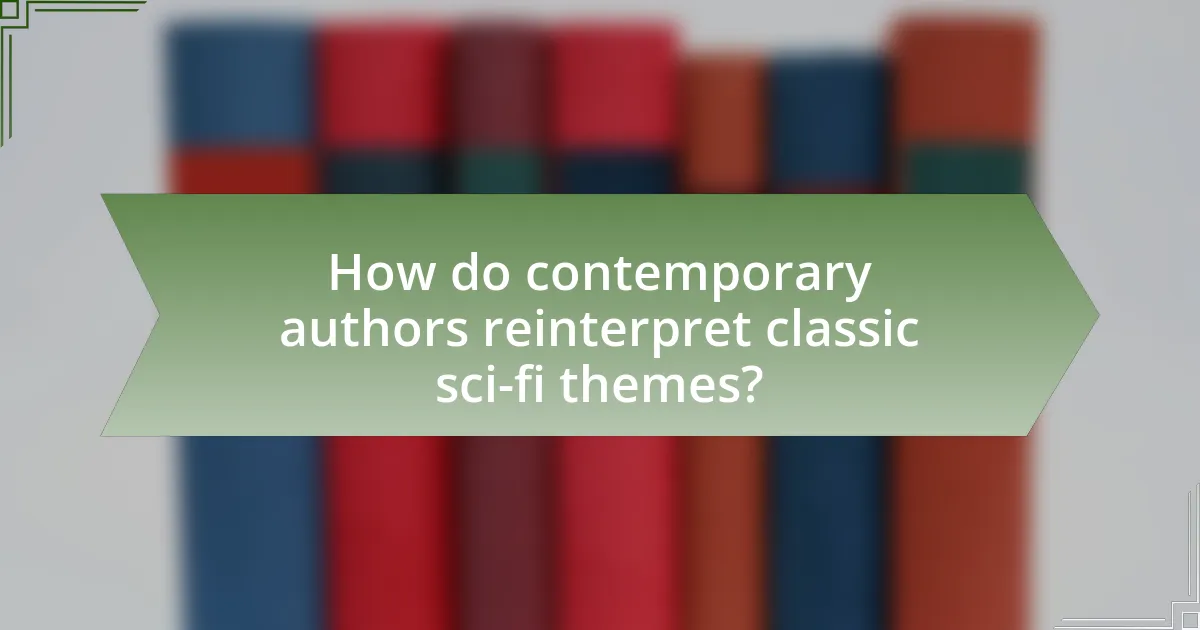
How do contemporary authors reinterpret classic sci-fi themes?
Contemporary authors reinterpret classic sci-fi themes by infusing them with modern social issues, technological advancements, and diverse perspectives. For instance, themes of dystopia and utopia, prevalent in the works of authors like Isaac Asimov and Philip K. Dick, are revisited in contemporary literature to address current concerns such as climate change, surveillance, and social inequality. Works like N.K. Jemisin’s “The Fifth Season” exemplify this by blending traditional sci-fi elements with themes of oppression and environmental catastrophe, reflecting contemporary societal challenges. Additionally, authors like Ted Chiang explore the implications of artificial intelligence and ethics, echoing classic themes while incorporating current technological realities. This approach not only honors the legacy of classic sci-fi but also makes it relevant to today’s readers, demonstrating how foundational themes can evolve to reflect the complexities of modern life.
What are some examples of contemporary works inspired by classic sci-fi?
Contemporary works inspired by classic sci-fi include “The Three-Body Problem” by Liu Cixin, which draws on themes of first contact and cosmic civilization reminiscent of Arthur C. Clarke’s works. Another example is “The Power” by Naomi Alderman, which explores gender dynamics in a way that echoes themes from Ursula K. Le Guin’s “The Left Hand of Darkness.” Additionally, “Children of Time” by Adrian Tchaikovsky reflects on evolution and artificial intelligence, concepts prevalent in Isaac Asimov’s stories. These works demonstrate the enduring influence of classic sci-fi on modern literature, showcasing how contemporary authors reinterpret foundational themes and ideas.
How do these contemporary works reflect or challenge the original themes?
Contemporary works reflect and challenge the original themes of classic sci-fi authors by reinterpreting concepts such as technology, identity, and societal structures. For instance, modern narratives often explore the implications of artificial intelligence and virtual realities, echoing themes from Isaac Asimov’s “I, Robot,” while simultaneously critiquing the ethical dilemmas associated with these advancements. Additionally, authors like Nnedi Okorafor in “Binti” challenge traditional notions of identity and cultural representation, expanding on themes of diversity and belonging that were less emphasized in earlier works. This evolution demonstrates how contemporary literature not only honors the foundational ideas of classic sci-fi but also adapts them to address current societal issues and perspectives.
What new perspectives do modern authors bring to classic sci-fi concepts?
Modern authors bring diverse perspectives to classic sci-fi concepts by incorporating themes of social justice, environmentalism, and technology’s ethical implications. For instance, authors like Nnedi Okorafor and Ted Chiang reimagine traditional narratives by exploring Afrofuturism and the moral dilemmas of artificial intelligence, respectively. This shift reflects contemporary societal concerns, such as climate change and systemic inequality, which were less emphasized in earlier works. Additionally, the rise of intersectionality in storytelling allows for a broader representation of marginalized voices, enriching the genre and challenging established norms. These modern interpretations not only honor the legacy of classic sci-fi but also expand its relevance in today’s cultural discourse.
How do readers perceive the influence of classic sci-fi in contemporary literature?
Readers perceive the influence of classic sci-fi in contemporary literature as significant and foundational. Many contemporary authors draw inspiration from classic works, incorporating themes, narrative structures, and speculative ideas that originated in earlier sci-fi. For instance, the exploration of dystopian societies in novels like “The Hunger Games” reflects the influence of classic dystopian works such as George Orwell’s “1984” and Aldous Huxley’s “Brave New World.” Additionally, readers often recognize the impact of classic sci-fi on character development and world-building, noting how these elements have evolved yet remain rooted in the traditions established by authors like Isaac Asimov and Philip K. Dick. This perception is supported by literary analyses that highlight the intertextual connections between classic and contemporary works, demonstrating a continuous dialogue across generations of writers.
What trends in reader preferences highlight the legacy of classic sci-fi?
Reader preferences increasingly favor themes of social commentary, technological exploration, and complex world-building, which highlight the legacy of classic sci-fi. Classic sci-fi authors like Isaac Asimov and Philip K. Dick laid the groundwork for these themes, influencing contemporary works that address current societal issues through speculative narratives. For instance, the resurgence of dystopian fiction reflects readers’ interests in exploring the implications of technology and governance, echoing the cautionary tales found in classic works. Additionally, the popularity of series like “The Expanse” demonstrates a continued appreciation for intricate world-building, a hallmark of classic sci-fi that resonates with modern audiences seeking immersive storytelling.
How does the reception of contemporary sci-fi reflect its classic roots?
The reception of contemporary sci-fi reflects its classic roots through thematic continuity and narrative structures that echo foundational works. Contemporary authors often draw inspiration from classic sci-fi themes such as dystopia, space exploration, and the ethical implications of technology, mirroring the concerns of pioneers like Isaac Asimov and Philip K. Dick. For instance, the resurgence of dystopian narratives in contemporary works, such as “The Hunger Games” by Suzanne Collins, parallels the societal critiques found in classic texts like George Orwell’s “1984.” Additionally, the use of speculative technology in modern sci-fi, as seen in works like “Neuromancer” by William Gibson, can be traced back to the imaginative foresight of classic authors who explored the impact of technological advancements on humanity. This intertextual relationship highlights how contemporary sci-fi not only honors but also evolves the foundational ideas established by its predecessors.
What can aspiring writers learn from the legacy of classic sci-fi authors?
Aspiring writers can learn the importance of imaginative world-building and thematic depth from the legacy of classic sci-fi authors. These authors, such as Isaac Asimov and Arthur C. Clarke, created intricate universes that explored complex social, ethical, and technological issues, demonstrating how speculative fiction can reflect and critique contemporary society. For instance, Asimov’s “Foundation” series delves into the rise and fall of civilizations, illustrating the impact of history on future events, while Clarke’s “2001: A Space Odyssey” examines humanity’s relationship with technology and the unknown. By studying these works, writers can understand how to weave compelling narratives that engage readers on multiple levels, encouraging them to think critically about the world around them.
How can understanding classic sci-fi enhance a writer’s craft?
Understanding classic sci-fi enhances a writer’s craft by providing foundational themes, narrative structures, and character archetypes that have shaped the genre. Classic sci-fi works, such as those by Isaac Asimov and Arthur C. Clarke, introduce complex ideas about technology, society, and human nature, which can inspire contemporary writers to explore similar themes in innovative ways. For instance, Asimov’s “Foundation” series emphasizes the impact of psychohistory on societal evolution, encouraging writers to think critically about the interplay between individual actions and larger historical forces. This understanding allows writers to create more nuanced and thought-provoking narratives that resonate with readers. Additionally, classic sci-fi often employs unique world-building techniques, which can help writers develop immersive settings that enhance their storytelling. By studying these elements, writers can refine their craft and contribute to the ongoing legacy of science fiction literature.
What best practices can writers adopt from classic sci-fi storytelling techniques?
Writers can adopt several best practices from classic sci-fi storytelling techniques, including the use of speculative world-building, character-driven narratives, and exploration of philosophical themes. Speculative world-building allows writers to create immersive settings that challenge readers’ perceptions of reality, as seen in works like Isaac Asimov’s “Foundation,” which constructs a vast universe governed by the laws of psychohistory. Character-driven narratives, exemplified by Arthur C. Clarke’s “2001: A Space Odyssey,” emphasize the emotional and psychological development of characters, making the story relatable despite its futuristic context. Additionally, classic sci-fi often delves into philosophical themes, such as the nature of humanity and technology’s impact on society, a technique effectively employed by Philip K. Dick in “Do Androids Dream of Electric Sheep?” These practices not only enhance storytelling but also engage readers in critical thinking about contemporary issues.
